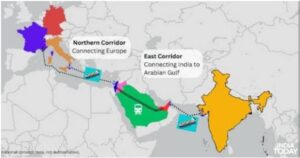Economic corridors drive sustainable growth
Relevance
- GS 3: Infrastructure – Energy, Ports, Roads, Airports, Railways
- Tags: #EconomicCorridors #IMEC #GlobalTrade #Mint #UPSC #CurrentAffairs #GS3Mains
Why in the News?
The announcement of the India-Middle East-Europe Economic Corridor (IMEC) at the G-20 Summit in New Delhi has sparked interest in economic corridors. These corridors play a vital role in connecting economic hubs and fostering development.
Economic Corridors: Catalysts of Regional Transformation
An “economic corridor,” a concept introduced by the Asian Development Bank, constitutes an integrated infrastructure network encompassing rail, road, and ports within a specified geographical area.
- These corridors serve to connect various economic hubs, bridging centers of production and consumption.
- Whether within a single nation (e.g., Delhi-Mumbai Industrial Corridor) or spanning multiple countries (e.g., China’s Belt and Road Initiative).
- These corridors are more than mere transportation links, they possess the power to revitalize and transform the regions they pass through.
Benefits of Economic Corridors
- Enhanced Logistics Efficiency: Economic corridors streamline logistics, reducing both time and costs associated with transportation.
- Industrial Clusters and Economic Growth: These corridors foster the emergence of industrial clusters, acting as catalysts for economic growth and development.
- Regional Transformation: Economic corridors can uplift underdeveloped regions by generating employment opportunities and elevating living standards.
- Impact of Belt and Road Initiative (BRI): A World Bank study predicts that China’s BRI, when fully realized, will cut travel time by 12%, boost trade by 2.7%, raise incomes by up to 3.4%, and alleviate extreme poverty for 7.6 million individuals.
IMEC’s Impact on India’s External Trade
- Efficiency and Cost Reduction: IMEC is expected to enhance efficiencies and reduce logistics costs, benefiting India’s external trade by making it more competitive.
- Economic Unity: The corridor promotes economic unity among the UAE, Saudi Arabia, India, and Europe, facilitating smoother trade relationships.
- Job Creation: IMEC’s development and operation are likely to generate employment opportunities in India, especially in sectors related to trade and transportation.
- Lower Emissions: By focusing on green hydrogen and green ammonia hubs, IMEC aligns with environmental goals, reducing greenhouse gas emissions and contributing to India’s sustainable image.
- Export Boost: The corridor will particularly benefit India’s engineering exports, which have the Middle East and Europe as key destinations.
- Competitiveness: Increased efficiency and cost-effectiveness will enhance the competitiveness of India’s export products, potentially expanding its market share
Well-Known Economic Corridors
- Silk Road: The historic Silk Road, spanning 6,400 kilometers and connecting the East and West for over 1,400 years, is one of the earliest economic corridors.
- Greater Mekong Subregion Economic Corridor: This corridor links Thailand, Cambodia, Vietnam, Laos, and Myanmar, promoting economic cooperation and development in the region.
- Almaty-Bishkek Economic Corridor: Connecting Almaty in Kazakhstan and Bishkek in Kyrgyzstan, this corridor enhances trade and connectivity between the two countries.
- China-Pakistan Economic Corridor (CPEC): CPEC is a prominent corridor connecting China and Pakistan, fostering economic collaboration and infrastructure development between the two nations.
Current Status of Belt and Road Initiative (BRI)
- Investment Milestone: The total investment in BRI projects has recently surpassed $1 trillion, highlighting its significant scale.
- Economic Slowdown: China appears to be reducing its commitment to BRI due to its own economic slowdown. Funding large projects in distant regions is becoming less appealing.
- Debt Concerns: BRI has faced criticism for burdening countries like Pakistan and Sri Lanka with debt, raising concerns about debt sustainability.
- Geopolitical Influence: Some nations accuse China of using BRI to gain strategic influence, often neglecting local needs, sovereignty, and environmental concerns.
IMEC (Infrastructure for the Middle East and Central Asia): Differentiating Factors
| Initiation | IMEC is part of the G7’s Partnership for Global Infrastructure Investment (PGII), launched in 2002 to counter the BRI. |
| Transparency | IMEC, part of the PGII, emphasizes transparency in all its funded projects, ensuring open and accountable operations. |
| Climate Resilience | IMEC places a strong emphasis on constructing climate change-resilient infrastructure, aligning with global sustainability goals. |
| Gender Equality | Gender equality is a core principle, with IMEC projects designed to promote equal opportunities and empowerment |
| Diversified Infrastructure | In addition to rail, road, and port infrastructure, IMEC includes pipelines for transporting clean hydrogen, addressing future energy needs sustainably. |
| Mobilization | PGII aims to collectively mobilize $600 billion by 2027 for infrastructure investment in emerging countries, differentiating it from other initiatives. |
India-Middle East-Europe Economic Corridor (IMEC) holds significant potential for regional development, improved logistics, and economic growth. However, lessons from previous initiatives like China’s Belt and Road Initiative (BRI) highlights the importance of transparency, environmental considerations, and local needs in their planning and execution.
Source: Mint, Business Line (TH)
Mains Question
Examine the potential benefits of the India-Middle East-Europe Economic Corridor (IMEC) announced at the G-20 Summit. How does IMEC align with the goals of promoting economic integration and sustainability?




